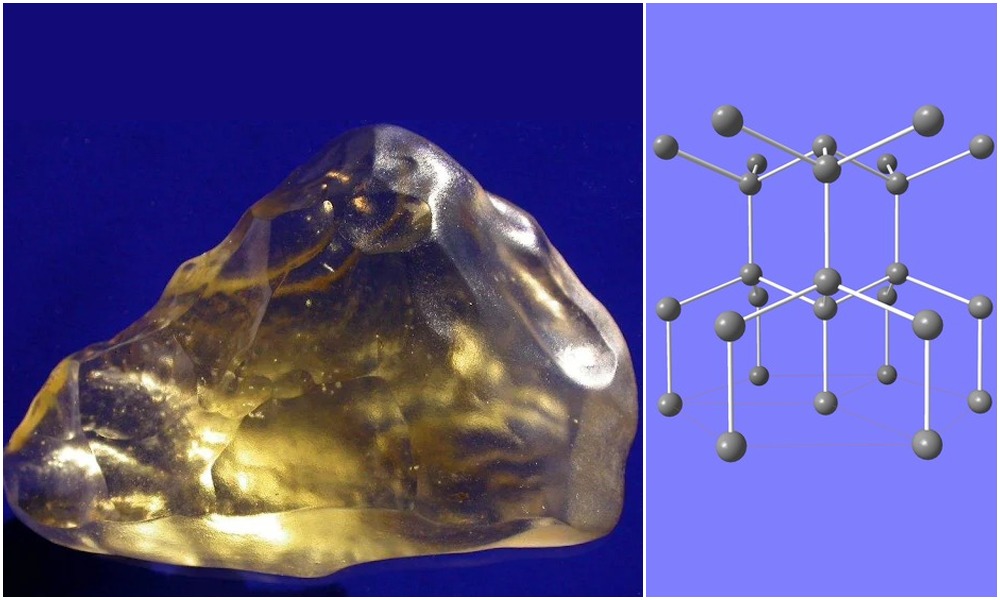DiamondBuzz
Lab grown Lonsdaleite: Chinese scientists create hexagonal diamond harder than natural diamonds

A groundbreaking discovery by Chinese scientists has led to the creation of an artificial diamond that surpasses natural diamonds in strength and heat resistance. Lonsdaleite is an allotrope of carbon that has a hexagonal crystal structure, rather than the cubic lattice of conventional diamond. It was first identified in 1967 from the Canyon Diablo meteorite, in Arizona, USA, regarded as one of the best-preserved meteorite craters on Earth. It was named after crystallographer Professor Dame Kathleen Lonsdale.
This new form, known as hexagonal diamond or lonsdaleite, has long been theorized to be harder than traditional diamonds but has remained difficult to synthesize in the lab. Recent advancements in material science have now made it possible, opening up exciting possibilities for industrial and commercial applications.
Scientists at Jilin University in China have successfully created an artificial diamond that surpasses natural ones in hardness and heat resistance. By heating compressed graphite under precise conditions, they have produced high-quality hexagonal diamonds, a structure known as lonsdaleite. This rare form, typically found in meteorite impact sites, has long been difficult to replicate in laboratories. The newly developed material exhibits remarkable structural integrity, promising advancements in various industries. A team from Jilin University and Sun Yat-sen University say their lab-grown version is at least 40 per cent harder and far more durable than a natural diamond.
“Our findings offer valuable insights regarding the graphite-to-diamond conversion under elevated pressure and temperature, providing opportunities for the fabrication and applications of this unique material,” they say in the journal Nature Materials.Their lab grown Lonsdaleite is likely to be used in a new generation of superconductors.

DiamondBuzz
PM Modi to visit Namibia; seeks to deepen economic ties in the diamond sector

Indian Prime Minister Narendra Modi is slated to visit Namibia on July 9, part of a five-nation tour that also includes Ghana, Argentina, Brazil, and Trinidad and Tobago. The trip marks Modi’s first official visit to the Southern African nation and underscores New Delhi’s ambition to deepen economic ties in the diamond sector.
While Indian firms such as Ankit Gems and KGK already run cutting and polishing units in Namibia’s capital, Windhoek, rough stones currently reach India indirectly via other global trading hubs. Modi’s visit is expected to pave the way for more direct diamond shipments, streamlining trade flows between the two countries.
Namibia ranks as the world’s fifth-largest diamond producer by value and volume, according to Kimberley Process data, and is especially known for its rich marine diamond reserves, estimated at over 80 million carats.
The agenda extends beyond gemstones. Modi is also set to discuss cooperation on critical minerals and uranium—resources vital to India’s clean energy ambitions and energy security. During the visit, he is scheduled to address the Namibian Parliament, signaling the strategic importance New Delhi places on closer engagement with Africa’s resource-rich economies.
DiamondBuzz
De Beers Unveils ‘Origin’: Blockchain-Backed Diamonds for a New Era of Transparency and Trust

De Beers Group has officially launched Origin, a pioneering initiative that brings blockchain technology to the heart of the natural diamond trade, offering consumers an unprecedented level of traceability, authenticity, and ethical assurance.
Each diamond in the Origin collection is individually verified and traceable, allowing customers to follow its journey from deep earth formation to expert craftsmanship and final retail presentation. The initiative is powered by tamper-proof blockchain technology, ensuring a secure and transparent record of each diamond’s provenance.
“As a brand, we understand that modern consumers value not just beauty, but also trust and purpose,” said De Beers during the launch. “Origin is our vision for a diamond industry that is transparent, ethical, and built on authenticity.”
The Origin platform not only affirms the diamond’s natural origin but also highlights its social and environmental impact—detailing the positive contributions made in the local communities where the stones are mined.
A Retailer-Ready Revolution
For retail partners, Origin offers more than just ethically sourced brilliance. It comes bundled with:
- Experiential merchandising solutions
- Custom marketing assets
- Retail staff training tools
These assets are designed to connect with today’s values-driven consumers, who seek deeper meaning and verified ethical sourcing in luxury purchases.
Origin also integrates seamlessly into retailers’ loose diamond portfolios, offering flexibility alongside elevated consumer confidence in the integrity and ethical story behind every stone.
The launch aligns with De Beers’ broader mission to lead the natural diamond industry toward a more responsible, transparent, and future-ready standard—where luxury is inseparable from accountability.
DiamondBuzz
Diamond Market Rebounds in 2025; India Emerges as Global Growth Engine

The global diamond industry is showing signs of revival in 2025, following two years of sluggish demand. According to Susan Jacques, President and CEO of the Gemological Institute of America (GIA), the gem and jewellery sector faced significant headwinds after a brief boom in 2021, which was fueled by pandemic-era shifts in consumer spending and travel behavior.
While 2022 saw strong pricing and demand, a downturn took hold through 2023 and 2024. Now, a renewed sense of optimism is emerging. “The recovery was expected, and we’re beginning to see positive momentum return,” Jacques noted.
A key driver of this rebound is India, whose cultural affinity for diamonds continues to underpin strong consumer interest. Over the past two decades, India’s share of global diamond demand has surged from just 2% to nearly 11%, positioning it as the world’s second-largest market for natural diamonds—trailing only the United States, which remains dominant with around 55% of total sales.
Pritesh Patel, Senior Vice President and Chief Operating Officer at GIA, remarked that the US market has remained stable in early 2025, and industry stakeholders are optimistic about sustained demand. In India, he observed a notable shift: interest in diamonds is expanding well beyond major metropolitan areas.

“Tier-2 and tier-3 cities are now driving growth, alongside established hubs,” Patel said. He added that demand is strong across India’s southern, northern, and western regions, signaling a broad-based recovery in diamond jewellery purchases.
The global industry is cautiously optimistic as it navigates 2025, buoyed by emerging markets and a renewed appetite for luxury adornments.
-

 National News2 months ago
National News2 months agoEmmadi Silver Jewellery Launches First Karnataka Store with Grand Opening in Bengaluru’s Malleshwaram
-

 BrandBuzz3 months ago
BrandBuzz3 months agoMia by Tanishq Unveils ‘Fiora’ Collection This Akshaya Tritiya: A Celebration of Nature’s Blossoms and New Beginnings
-

 GlamBuzz2 months ago
GlamBuzz2 months agoGokulam Signature Jewels Debuts in Hyderabad with Glamorous Launch at KPHB
-

 DiamondBuzz2 months ago
DiamondBuzz2 months agoDe Beers CEO: confident the US will exempt diamonds from reciprocal tariffs











